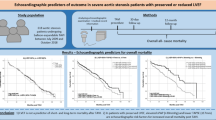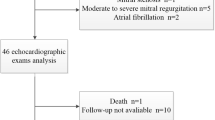Abstract
This study applies L-wave measurements of mid-diastolic trans-mitral flow. Although considered to be a marker of elevated filling pressure or delayed myocardial relaxation, its clinical and prognostic value is yet to be completely elucidated. It has been shown that transcatheter aortic valve replacement (TAVR) induces reverse remodeling and improves diastolic function and prognosis in patients with severe aortic stenosis (AS). Our purpose was to evaluate the prognostic value of L-wave following TAVR. We examined clinical and echocardiographic data of patients undergoing TAVR. L-Wave presence and velocity were recorded at baseline and at 1 month and 6 months following TAVR. The effect of the procedure on L-wave measurements and its impact on mortality and other clinical outcomes were analyzed. A total of 502 patients (mean age 82.58 ± 5.9) undergoing TAVR were included. Patients with baseline L-wave (n = 68, 12%) had a smaller stroke volume index by 5.7 ± 2.3 ml/m2 (p = 0.01) as compared to patients without L-wave at baseline. L-waves disappeared In 35% and 70% of patients at 1 month and at 6 months respectively. Baseline L-wave velocity was 34.8 ± 11.5 (cm/s) and decreased significantly at follow-up examinations. Patients with persistent L-wave following TAVR had higher 3-year adjusted mortality rates (HR 5.7, 95% CI 3.7–8.9, p < 0.001). Multivariate analysis of survival was also statistically significant (p < 0.001). TAVR induces L-wave disappearance and a decrease in L-wave velocity in patients with severe AS. L-wave persistence following TAVR is an independent risk factor for mortality.



Similar content being viewed by others
References
Little WC, Warner JG, Rankin KM et al (1998) Evaluation of left ventricular diastolic function from the pattern of left ventricular filling. Clin Cardiol 21:5–9
Kerut EK (2008) The mitral L-wave: a relatively common but ignored useful finding. Echocardiography 25:548–550. https://doi.org/10.1111/j.1540-8175.2007.00626.x
Ha J-W, Oh JK, Redfield MM et al (2004) Triphasic mitral inflow velocity with middiastolic filling: clinical implications and associated echocardiographic findings. J Am Soc Echocardiogr 17:428–431. https://doi.org/10.1016/j.echo.2004.02.007
Lam CSP, Han L, Ha J-W et al (2005) The mitral L wave: A marker of pseudonormal filling and predictor of heart failure in patients with left ventricular hypertrophy. J Am Soc Echocardiogr 18:336–341. https://doi.org/10.1016/j.echo.2004.10.019
Oh JK, Hatle L, Tajik AJ, Little WC (2006) Diastolic heart failure can be diagnosed by comprehensive two-dimensional and Doppler echocardiography. J Am Coll Cardiol 47:500–506. https://doi.org/10.1016/j.jacc.2005.09.032
Ghosh E, Caruthers SD, Kovács SJ (2014) E-wave generated intraventricular diastolic vortex to L-wave relation: model-based prediction with in vivo validation. J Appl Physiol 117:316–324. https://doi.org/10.1152/japplphysiol.00215.2014
Keren G, Meisner JS, Sherez J et al (1986) Interrelationship of mid-diastolic mitral valve motion, pulmonary venous flow, and transmitral flow. Circulation 74:36–44. https://doi.org/10.1161/01.CIR.74.1.36
Masai K, Mano T, Goda A et al (2018) Correlates and prognostic values of appearance of L wave in heart failure patients with preserved vs. Reduced ejection fraction. Circul J 82:2311–2316. https://doi.org/10.1253/circj.CJ-18-0417
Oh JK, Park S-J, Nagueh SF (2011) Established and novel clinical applications of diastolic function assessment by echocardiography. Circulation 4:444–455. https://doi.org/10.1161/CIRCIMAGING.110.961623
Kampaktsis PN, Kokkinidis DG, Wong S-C et al (2017) The role and clinical implications of diastolic dysfunction in aortic stenosis. Heart 103:1481–1487. https://doi.org/10.1136/heartjnl-2017-311506
Voigtländer L, Seiffert M (2018) Expanding TAVI to low and intermediate risk patients. Front Cardiovasc Med. https://doi.org/10.3389/fcvm.2018.00092
Puri R, Iung B, Cohen DJ, Rodés-Cabau J (2016) TAVI or No TAVI: identifying patients unlikely to benefit from transcatheter aortic valve implantation. Eur Heart J 37:2217–2225. https://doi.org/10.1093/eurheartj/ehv756
Poulin F, Carasso S, Horlick EM et al (2014) Recovery of left ventricular mechanics after transcatheter aortic valve implantation: effects of baseline ventricular function and postprocedural aortic regurgitation. J Am Soc Echocardiogr 27:1133–1142. https://doi.org/10.1016/j.echo.2014.07.001
Nagueh SF, Smiseth OA, Appleton CP et al (2016) Recommendations for the evaluation of left ventricular diastolic function by echocardiography: an update from the American Society of Echocardiography and the European Association of Cardiovascular Imaging. J Am Soc Echocardiogr 29:277–314. https://doi.org/10.1016/j.echo.2016.01.011
Lang RM, Badano LP, Mor-Avi V et al (2015) Recommendations for cardiac chamber quantification by echocardiography in adults: an update from the American Society of Echocardiography and the European Association of Cardiovascular Imaging. J Am Soc Echocardiogr 28:1–39.e14. https://doi.org/10.1016/j.echo.2014.10.003
Ha J, Ahn J, Moon J et al (2006) Triphasic mitral inflow velocity with mid-diastolic flow: the presence of mid-diastolic mitral annular velocity indicates advanced diastolic dysfunction☆. Eur J Echocardiogr 7:16–21. https://doi.org/10.1016/j.euje.2005.03.007
Athappan G, Patvardhan E, Tuzcu EM et al (2013) Incidence, predictors, and outcomes of aortic regurgitation after transcatheter aortic valve replacement: meta-analysis and systematic review of literature. J Am Coll Cardiol 61:1585–1595. https://doi.org/10.1016/j.jacc.2013.01.047
From pressure overload to volume overload: aortic regurgitation after transcatheter aortic valve implantation. - PubMed - NCBI. https://www.ncbi.nlm.nih.gov/pubmed/22709742. Accessed 9 Feb 2019
Nadruz W, Claggett B, Gonçalves A et al (2016) Smoking and cardiac structure and function in the elderly: the ARIC Study (Atherosclerosis Risk in Communities). Circ Cardiovasc Imaging 9:e004950. https://doi.org/10.1161/CIRCIMAGING.116.004950
Ferrara F, Rudski LG, Vriz O et al (2016) Physiologic correlates of tricuspid annular plane systolic excursion in 1168 healthy subjects. Int J Cardiol 223:736–743. https://doi.org/10.1016/j.ijcard.2016.08.275
Fang F, Zhang Q, Chan JYS et al (2011) Deleterious effect of right ventricular apical pacing on left ventricular diastolic function and the impact of pre-existing diastolic disease. Eur Heart J 32:1891–1899. https://doi.org/10.1093/eurheartj/ehr118
Mohananey D, Jobanputra Y, Kumar A et al (2017) Clinical and echocardiographic outcomes following permanent pacemaker implantation after transcatheter aortic valve replacement. Circulation 10:e005046. https://doi.org/10.1161/CIRCINTERVENTIONS.117.005046
Töger J, Kanski M, Carlsson M et al (2012) Vortex ring formation in the left ventricle of the heart: analysis by 4D flow MRI and lagrangian coherent structures. Ann Biomed Eng 40:2652–2662. https://doi.org/10.1007/s10439-012-0615-3
Kovács SJ (2015) Diastolic function in heart failure. Clin Med Insights. https://doi.org/10.4137/CMC.S18743
Kim S-A, Son J, Shim C-Y et al (2017) Long-term outcome of patients with triphasic mitral flow with a mid-diastolic L wave: prognostic role of left atrial volume and N-terminal pro-brain natriuretic peptide. Int J Cardiovasc Imaging 33:1377–1384. https://doi.org/10.1007/s10554-017-1122-2
Su H-M, Lin T-H, Hsu P-C et al (2013) Incremental prognostic value of identifying mitral L wave in patients with atrial fibrillation. Int J Cardiol 168:4501–4503. https://doi.org/10.1016/j.ijcard.2013.06.118
Nakai H, Takeuchi M, Nishikage T et al (2007) The mitral L wave: a marker of advanced diastolic dysfunction in patients with atrial fibrillation. Circ J 71:1244–1249
Davies C, Zerebiec K, Rożanowska A et al (2018) Is left ventricular hypertrophy a friend or foe of patients with aortic stenosis? Adv Interv Cardiol 14:328–337. https://doi.org/10.5114/aic.2018.78734
Kayama S, Aratake S, Sawamura S et al (2013) Medium and long-term prognosis of transcatheter aortic valve implantation from the perspective of left ventricular diastolic function. Cardiol J. https://doi.org/10.5603/CJ.a2018.0005
Muratori M, Fusini L, Tamborini G et al (2016) Sustained favourable haemodynamics 1 year after TAVI: improvement in NYHA functional class related to improvement of left ventricular diastolic function. Eur Heart J 17:1269–1278. https://doi.org/10.1093/ehjci/jev306
Kramer J, Biner S, Ghermezi M et al (2017) Impact of left ventricular filling parameters on outcome of patients undergoing trans-catheter aortic valve replacement. Eur Heart J Cardiovasc Imaging 18:304–314. https://doi.org/10.1093/ehjci/jew097
Suzuki-Eguchi N, Murata M, Itabashi Y et al (2018) Prognostic value of pre-procedural left ventricular strain for clinical events after transcatheter aortic valve implantation. PLoS ONE 13:e0205190. https://doi.org/10.1371/journal.pone.0205190
Maayan K, Simon B, Yan T et al (2014) Predictors of improvement in diastolic function after transcatheter aortic valve implantation. J Echocardiogr 12:17–23. https://doi.org/10.1007/s12574-013-0195-8
Broyd CJ, Rigo F, Nijjer S et al (2018) Regression of left ventricular hypertrophy provides an additive physiological benefit following treatment of aortic stenosis: Insights from serial coronary wave intensity analysis. Acta Physiol 224:e13109. https://doi.org/10.1111/apha.13109
Acknowledgements
All authors contributed to the study conception and design. Material preparation, data collection and analysis were performed by Drs. Ilan Merdler and Aviram Hochstadt. The first draft of the manuscript was written by Drs. Ilan Merdler and Itamar Loewenstein and all authors commented on previous versions of the manuscript. All authors read and approved the final manuscript.
Author information
Authors and Affiliations
Corresponding author
Ethics declarations
Conflict of interest
The authors whose names are listed above certify that they have NO affiliations with or involvement in any organization or entity with any financial interest or non-financial interest in the subject matter or materials discussed in this manuscript. This research did not receive any specific grant from funding agencies in the public, commercial, or not-for-profit sectors. All Authors have seen and approved the manuscript being submitted. We warrant that the article is the Authors' original work. We warrant that the article has not received prior publication and is not under consideration for publication elsewhere. On behalf of all Co-Authors, the corresponding Author shall bear full responsibility for the submission.
Additional information
Publisher's Note
Springer Nature remains neutral with regard to jurisdictional claims in published maps and institutional affiliations.
Rights and permissions
About this article
Cite this article
Merdler, I., Richert, E., Hochstadt, A. et al. Echocardiographic L-wave as a prognostic indicator in transcatheter aortic valve replacement. Int J Cardiovasc Imaging 36, 1897–1905 (2020). https://doi.org/10.1007/s10554-020-01903-8
Received:
Accepted:
Published:
Issue Date:
DOI: https://doi.org/10.1007/s10554-020-01903-8




